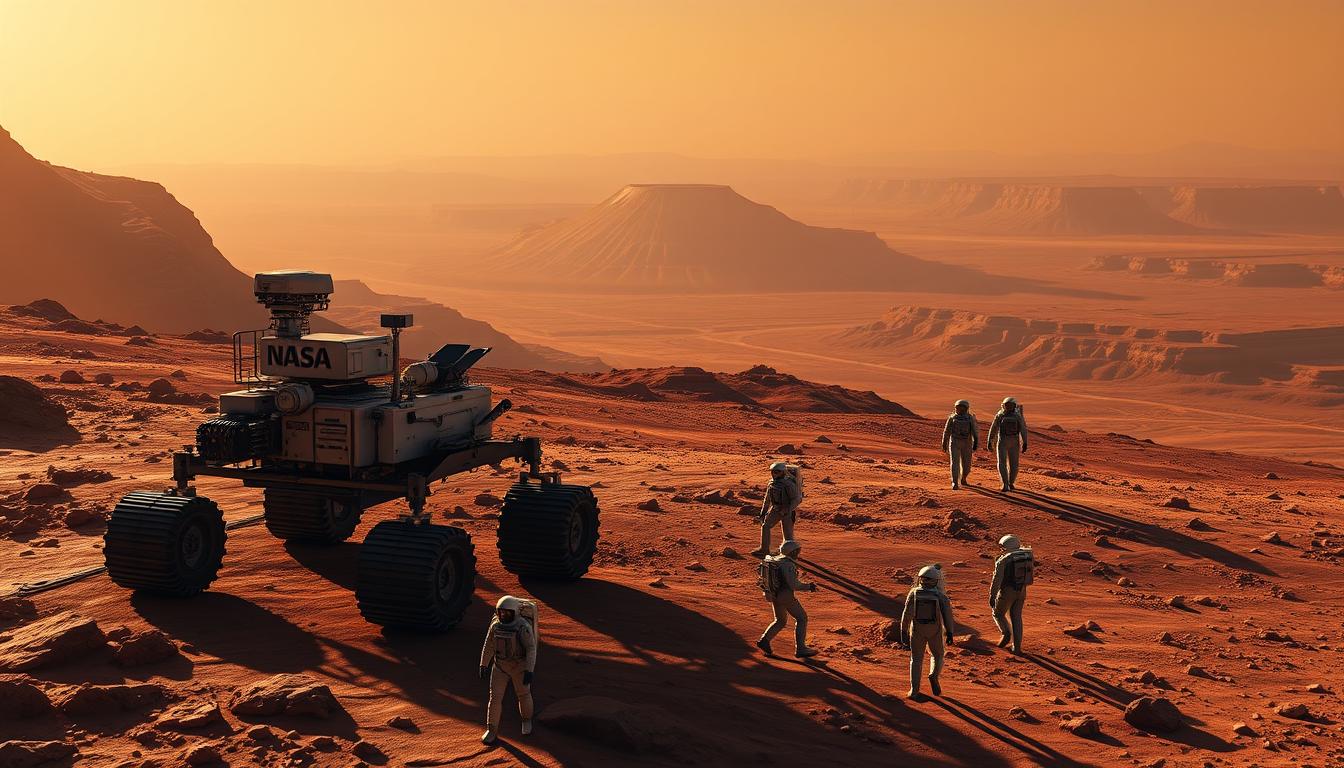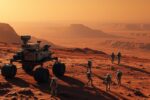NASA is making significant strides in its plans for sending astronauts to Mars as part of its long-term space exploration strategy. The journey to Mars is considered one of humanity’s greatest challenges, requiring major technological innovations and years of preparation.
The mission to Mars introduces complex challenges related to life support, radiation protection, and psychological factors during the multi-month journey. It will build upon decades of robotic exploration and knowledge gained from the Artemis lunar program.
This historic mission represents a significant step forward for human space exploration and potentially the beginning of humanity’s multi-planetary future.
Key Takeaways
- NASA is developing comprehensive plans for sending humans to Mars in the 2030s.
- The mars mission will require significant technological innovations and international collaboration.
- The mission will build upon decades of robotic exploration and knowledge gained from the Artemis lunar program.
- Complex challenges related to life support, radiation protection, and psychological factors need to be addressed.
- The mission represents a significant step forward for human space exploration.
The Red Planet Beckons: NASA’s Mars Vision
With a clear vision for the future, NASA is paving the way for humanity’s next giant leap: a manned mission to Mars. This endeavor is not just about reaching another planet; it’s about advancing our understanding of the universe and our place within it.
Why Mars Is Humanity’s Next Destination
Mars has captivated human imagination for centuries, and NASA’s current plans are bringing us closer to making a human presence on the Red Planet a reality. The allure of Mars lies in its potential to answer fundamental questions about life beyond Earth and the history of our solar system.
Key questions that NASA aims to address include:
- Was Mars ever home to microbial life?
- Could Mars support human life in the future?
- What can Mars teach us about the origins of life on Earth?
NASA’s Long-term Goals for Mars Exploration
NASA’s strategy for Mars exploration is progressive and multifaceted. The agency’s long-term vision includes:
- Establishing a sustained human presence on Mars
- Developing necessary technologies for deeper space exploration, such as advanced propulsion systems and closed-loop life support
- Fostering international and commercial partnerships to leverage global expertise and resources
By pursuing these goals, NASA is not only working towards a manned mission to Mars but also laying the groundwork for future exploration of the solar system.
Timeline for the First Human Mission to Mars
NASA’s plans for the first human mission to Mars are taking shape, with a focus on creating a comprehensive timeline that encompasses all aspects of the missions.
Current Target Dates and Mission Roadmap
NASA has been working diligently to establish a realistic timeline for the first human mission to Mars. The agency is leveraging lessons learned from the Artemis program to inform the exploration strategy for Mars.
When astronauts travel to Mars and back, their vehicle will return home with more than a billion miles on its odometer — more than a thousand times the distance that Artemis I traveled. This significant milestone underscores the complexity and scale of the upcoming human exploration endeavor.
The current roadmap involves several critical steps, including the development of necessary technologies and the testing of life support systems capable of sustaining astronauts for extended periods in space.
Artemis Program as a Stepping Stone
The Artemis program is serving as a crucial technological and operational bridge between current capabilities and those needed for Mars missions. Lunar missions allow astronauts to test life support systems, habitation modules, and surface operations in a deep space environment.
- The Gateway lunar orbital platform will validate critical technologies for long-duration missions, including radiation protection and autonomous systems.
- Experience gained during extended stays on the lunar surface will inform Mars mission planning, particularly regarding resource utilization and habitat construction.
- The Space Launch System and Orion spacecraft developed for Artemis provide the foundation for the more powerful launch vehicles and spacecraft needed for Mars exploration.
By leveraging the Artemis program as a stepping stone, NASA is making significant strides towards establishing a robust and reliable presence in space, ultimately paving the way for the first human mission to Mars.
The Journey to Mars: Transit Challenges and Solutions
The journey to Mars is a complex task that poses significant challenges, from the distance and travel duration to the design of the spacecraft. As NASA plans for the first human mission, addressing these challenges is crucial.
Distance and Travel Duration
The distance between Earth and Mars varies due to their elliptical orbits, with the closest approach being about 56 million kilometers. The travel duration can range from 6 to 9 months, depending on the specific trajectory and the positions of the two planets. This long duration poses significant challenges for the crew, including the need for reliable life support systems and adequate radiation shielding.
Launch Windows and Orbital Mechanics
Launch windows for Mars missions occur every 26 months, when Earth and Mars are aligned in their orbits. This alignment, known as opposition, allows for the most energy-efficient journey. The vehicle must be launched during this window to take advantage of the favorable orbital mechanics. The mission plan must also consider the orbital mechanics of both Earth and Mars to ensure a precise trajectory.
Spacecraft Design Requirements
The spacecraft for the first human mission to Mars will be the most complex vehicle ever built, requiring multiple launches and in-space assembly before departure. Key design requirements include radiation shielding, reliable life support systems capable of functioning for years without resupply, and sufficient habitable volume to maintain crew health during the long journey. The spacecraft must also be designed to accommodate both artificial gravity and zero-gravity operations, addressing the physiological challenges of long-duration flight. Advanced technologies and technology will be needed to support these requirements, ensuring the success of the mission in the harsh environment of space.
The vehicle architecture will likely include multiple modules: a propulsion element, habitation module, logistics module, and a Mars lander/ascent vehicle. Redundant systems are essential for mission success, as the spacecraft must operate autonomously with no possibility of quick return to Earth in case of emergencies.
Life Support Systems for the Mars Mission
As NASA plans for the first human mission to Mars, developing reliable life support systems is crucial. The mission will require sustaining life for months, making it essential to have systems in place for air, water, and food.
Air and Water Recycling Technologies
One of the critical components of life support systems is air and water recycling. Technologies that can recycle air and water are vital for a mission that will last several months. NASA is developing systems that can recycle air and water efficiently, minimizing the need for resupply.
For instance, air recycling technologies can remove carbon dioxide from the air and produce oxygen, making it possible for astronauts to breathe. Similarly, water recycling technologies can purify wastewater, making it safe for consumption. These technologies are crucial for sustaining life during the mission.
| Technology | Description | Benefits |
|---|---|---|
| Air Recycling | Removes CO2 and produces O2 | Sustains life, reduces need for oxygen supply |
| Water Recycling | Purifies wastewater | Conserves water, reduces waste |
Food Production and Sustainability
Food production is another critical aspect of life support systems for the Mars mission. Since resupply missions will not be feasible, astronauts will have to rely on stored food and in-situ food production. NASA is researching ways to grow food in space, including hydroponics and aeroponics.
As noted by experts, “Growing food in space is not just about sustenance; it’s also about maintaining the mental health of astronauts on long-duration missions.”
“The psychological benefits of having fresh food cannot be overstated, especially on a mission that could last several months or even years.”
NASA is also exploring ways to make the Martian regolith usable for growing plants, despite the challenges posed by the lack of organic material and the presence of perchlorates. The goal is to create a sustainable food system that can support astronauts during their stay on Mars.

- Combining shelf-stable foods with compact growing systems for fresh produce.
- Utilizing bioregenerative systems that consume CO2 and produce O2.
- Focusing on high-value crops like leafy greens and tomatoes.
Radiation Protection: Keeping Astronauts Safe
One of the critical hurdles for human missions to Mars is safeguarding astronauts against cosmic radiation. Space radiation poses a significant threat to both the crew and electronic equipment on spacecraft.
Health Risks from Cosmic Radiation
Cosmic radiation is a major concern for deep space missions. In May 2013, NASA scientists reported that a possible mission to Mars could involve significant radiation risk. The radiation assessment detector (RAD) on the Mars Science Laboratory measured energetic particle radiation during its journey from Earth to Mars in 2011-2012, calculating a radiation dose of 0.66 sieverts round-trip, which is close to the career radiation limit for astronauts of 1 sievert.
Shielding Technologies and Strategies
Effective radiation protection requires a multi-layered approach. Several strategies are being explored, including the use of passive shielding materials, strategic habitat design, and operational protocols. Water and polyethylene are among the most effective passive radiation shields. NASA is researching ways to integrate water storage and waste processing systems into the spacecraft walls. Advanced materials like hydrogen-rich composites and boron nitride nanotubes are also being investigated for their radiation attenuation properties.
| Shielding Material | Effectiveness | Application |
|---|---|---|
| Water | High | Storage and waste processing |
| Polyethylene | High | Spacecraft walls |
| Regolith | High | Martian surface habitats |
On the Martian surface, regolith can provide effective radiation shielding, leading to habitat designs that utilize buried or regolith-covered structures. Active radiation shielding using superconducting magnets is also being researched, though it faces significant technical challenges.
Landing Humans on the Martian Surface
As NASA plans its first human mission to Mars, the challenge of landing on the Martian surface is a significant hurdle. The process of entering Mars’ atmosphere and descending to the surface is fraught with difficulties due to the planet’s thin and shallow atmosphere.

Mars Entry, Descent, and Landing Challenges
Entry into the Martian atmosphere poses significant difficulties with re-entry; compared to Earth’s much denser atmosphere, any spacecraft will descend very rapidly to the surface and must be slowed. A heat shield has to be used to protect the spacecraft from the intense heat generated during this phase.
NASA is carrying out research on retropropulsive deceleration technologies to develop new approaches to Mars atmospheric entry. The key problem with propulsive techniques is handling the fluid flow problems and attitude control of the descent vehicle during the rocket-powered phase of the entry and deceleration.
Supersonic Retropropulsion and Other Landing Technologies
Landing humans on Mars requires innovative solutions. Some of the key technologies being developed include:
- Supersonic retropropulsion—firing rockets while moving faster than the speed of sound through the Martian atmosphere—is a critical technology being developed for human-scale Mars landings.
- Inflatable heat shields and aerodynamic decelerators offer promising alternatives by increasing the drag area without significantly increasing the mass of the entry system.
- Precision landing technologies using terrain relative navigation allow the spacecraft to identify surface features and adjust its trajectory to land within meters of the intended target.
These advancements are crucial for the success of future missions to Mars.
Living on Mars: Habitat Designs and Life Support
Creating a habitable environment on Mars is essential for the success of future human missions, focusing on both habitat design and life support. The Martian environment poses significant challenges, including a thin atmosphere, low temperatures, and lack of liquid water.
Mars Habitat Concepts and Requirements
Designing habitats for Mars involves creating structures that can protect astronauts from the harsh environment. These habitats must be capable of maintaining a safe internal atmosphere, providing insulation against cold temperatures, and shielding against radiation. In-situ resource utilization (ISRU) will play a crucial role in establishing these habitats by using local materials for construction and life support.
The Martian regolith can be used for radiation shielding and potentially as a growth medium for plants after processing. The habitat must also be designed to accommodate the psychological needs of the astronauts during the long-duration mission.
| Habitat Requirement | Description | Martian Resource Utilization |
|---|---|---|
| Atmosphere | Maintaining a safe internal atmosphere | Using Martian atmosphere to produce oxygen |
| Radiation Shielding | Protecting against cosmic radiation | Utilizing Martian regolith for shielding |
| Temperature Control | Insulating against cold temperatures | Using local materials for insulation |
Using Mars Resources for Survival (ISRU)
The Mars Oxygen In-Situ Resource Utilization Experiment (MOXIE) has demonstrated the ability to produce oxygen from the Martian atmosphere, which is composed of 96% carbon dioxide. This technology is crucial for future missions as it can be used for both life support and rocket propellant. Additionally, extracting water from subsurface ice deposits will be essential for drinking, growing food, and producing hydrogen for fuel.
The use of ISRU reduces the need to transport resources from Earth, making missions more sustainable and economically feasible. By leveraging Martian resources, NASA can significantly reduce the mass that needs to be launched, thereby making human missions to Mars more viable.
Early ISRU systems will likely be deployed robotically before human arrival to verify operation and begin producing essential resources like oxygen and water in advance.
The First Human Mission to Mars: Crew Selection and Training
Crew selection and training are critical components of NASA’s strategy for a successful mission to Mars. The process involves not only selecting the right astronauts but also preparing them for the challenges they will face on their journey.
Astronaut Requirements and Selection Process
NASA’s astronaut selection process is rigorous, seeking individuals with a unique blend of scientific knowledge, physical stamina, and mental resilience. The training program for Mars missions will be the most comprehensive in spaceflight history, spanning 3-5 years. This extensive preparation will cover a wide range of topics, from spacecraft systems to geology, medicine, and emergency procedures.
- Analog environments on Earth, such as NASA’s CHAPEA facility, will simulate aspects of the Mars mission to prepare crews.
- Medical training will be extensive, enabling crew members to handle various health issues with minimal external support.
Specialized Training for Mars Missions
The training for Mars missions will include technical, scientific, and medical aspects. Technical training will ensure that all crew members can maintain and repair critical systems, with cross-training for redundancy in essential skills. The missions to Mars will last several months, and potentially, hundreds of days, in space.
- Scientific training will prepare astronauts to maximize research value, focusing on geology, biology, and atmospheric science.
- Virtual and augmented reality technologies will play a significant role in training, allowing astronauts to practice Mars surface operations in realistic simulated environments.
Scientific Goals and Exploration Plans
As NASA plans its first human mission to Mars, the scientific goals and exploration plans are taking shape. The mission will focus on several key areas of research, building on the foundation established by previous robotic missions.
Priority Research Areas on Mars
The Red Planet offers a unique environment for scientific research, with several priority areas identified for the first human mission. These include the search for water and understanding the Martian geology. Scientists will investigate the planet’s surface and subsurface to gain insights into its history and potential habitability.
- Understanding Martian geology and its implications for the planet’s history
- Searching for signs of past or present water on Mars
- Investigating the Martian environment’s potential for supporting life
Sample Collection and Analysis
A cornerstone of the first human mission to Mars will be sample collection and analysis. Building on the work of robotic missions like the Perseverance rover, which has been collecting samples since 2021, human explorers will be able to make real-time decisions about sampling locations and collect a diverse range of materials.
- Collecting samples from various geological units and environments
- Conducting on-site analysis using laboratories within the Mars habitat
- Selecting the most valuable samples for potential return to Earth on future missions
This approach will significantly enhance our understanding of Mars and its potential for supporting life, bringing us closer to answering whether we are alone on the planet we call Mars or the Red Planet.
International Collaboration and Private Partnerships
NASA’s Mars mission is leveraging global collaboration and private sector innovation to achieve its ambitious goals. The space exploration landscape is changing, with multiple countries and commercial entities working together to push the boundaries of what is possible.
Space Agencies’ Cooperative Efforts
International cooperation is a hallmark of modern space exploration. The International Space Station and the proposed Lunar Gateway are prime examples of global collaboration. For the Mars mission, space agencies around the world are sharing resources, expertise, and risk. This cooperative approach not only accelerates progress but also fosters a sense of global unity in the pursuit of exploring the red planet.
Collaborative efforts include sharing data, technology, and even crew training programs. By working together, space agencies can pool their resources to develop the necessary technologies and strategies for a successful Mars mission.
| Space Agency | Contribution |
|---|---|
| NASA | Leadership and Technological Innovation |
| ESA | Service Module and Communication Equipment |
| CNSA | Scientific Instruments and Crew Training |
Commercial Space Companies’ Contributions
Commercial space companies are playing a vital role in NASA’s Mars plans. Private launch providers like SpaceX are developing heavy-lift rockets capable of sending large payloads to Mars. Companies such as Boeing and Lockheed Martin are also contributing by developing advanced spacecraft and vehicle technologies.
The commercial sector brings agility and innovation to Mars mission planning. Public-private partnerships are being established, following models like those in the Artemis program, where NASA purchases services rather than hardware. This approach stimulates commercial innovation and potentially reduces costs. For instance, commercial habitat developers are creating modules that could be adapted for Mars transit or surface use, leveraging their experience with ISS commercial modules.
Conclusion: The Future of Humanity as a Multi-Planetary Species
The first human mission to Mars is more than a technological feat; it’s a milestone in human history, marking our species’ expansion into the solar system. This mission represents a significant step forward in human exploration, establishing a presence on another planet for the first time.
While initial missions will be exploratory, they lay the groundwork for potential long-term settlement of Mars over the coming years. Becoming a multi-planetary species provides humanity with a form of “cosmic insurance,” protecting against extinction-level events.
The technologies developed for Mars missions will drive innovation on Earth, from sustainable life support systems to advanced energy production. The mission will also inspire a new generation of scientists and engineers, just as the Apollo program did, creating a powerful educational impact.
As we embark on this journey, we are not just expanding our presence in the solar system; we are reshaping our collective identity and understanding of humanity’s place in it. The first human mission to Mars is one of the most significant endeavors of the 21st century, with rewards that include scientific discovery, technological advancement, and the expansion of human civilization.
In the years to come, this mission will be remembered as a pivotal moment in the history of space exploration, marking the beginning of a new era in human presence in the solar system.









